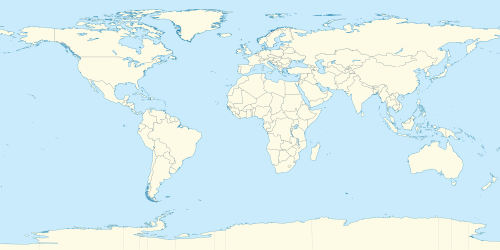The Globalization and World Cities Research Network (GaWC) is a think tank that studies the relationships between world cities in the context of globalization. It is based in the geography department of Loughborough University in Leicestershire, United Kingdom. GaWC was founded by Peter J. Taylor in 1998.[2] Together with Jon Beaverstock and Richard G. Smith, they create the GaWC's biennial categorization of world cities into "Alpha", "Beta" and "Gamma" tiers, based upon their international connectedness.[3]
 | |
| Established | 1998 |
|---|---|
| Director | Peter J. Taylor |
| Location | Loughborough, United Kingdom |
| Website | lboro.ac.uk/gawc |
GaWC city classification
The GaWC examines cities worldwide to narrow them down to a roster of world cities, then ranks these based on their connectivity through four "advanced producer services": accountancy, advertising, banking/finance, and law.[4] The GaWC inventory ranks city economics more heavily than political or cultural factors. Beyond the categories of "Alpha" world cities (with four sub-categories), "Beta" world cities (three sub-categories), and "Gamma" world cities (three sub-categories), the GaWC cities include additional cities at "High sufficiency" and "Sufficiency" level.
GaWC published city classifications in 1998, 2000, 2004, 2008, 2010, 2012, 2016, 2018, and 2020.[5] The 2004 rankings added several new indicators while continuing to rank city economics more heavily than political or cultural factors. The 2008 roster, similar to the 1998 version, is sorted into categories of Alpha world cities (with four sub-categories), Beta world cities (three sub-categories), Gamma world cities (three sub-categories), and additional cities with High sufficiency or Sufficiency presence. The list has been prone to change in the ranks. For example, some cities that were selected prior to 2018, such as the United States cities of Greensboro and Providence, are no longer classified as sufficient level.[6][7]
2022 city classification
The classification results for 2022 are derived from the activities of 175 leading firms providing advanced producer services across 802 cities worldwide. The results should be interpreted as indicating the importance of cities as nodes in the world city network (i.e. enabling corporate globalization).[8] The cities in the 2022 classification are as follows.[9]
( 1) or (
1) or ( 1) indicates a city moved one category up or down since the 2020 classification.[10]
1) indicates a city moved one category up or down since the 2020 classification.[10]
Alpha
Alpha level cities are linked to major economic states/regions and highly integrated into the world economy. Alpha level cities are classified into four sections: Alpha ++, Alpha +, Alpha, and Alpha − cities.
Alpha ++
Alpha ++ cities are cities most integrated with the global economy:
Alpha +
Alpha + are "other highly integrated cities that complement London and New York, largely filling in advanced service needs for the Pacific/Asia [region]":[11]
Alpha

 Amsterdam
Amsterdam
 Brussels
Brussels Chicago
Chicago
 Frankfurt
Frankfurt Istanbul (
Istanbul ( 1)
1) Jakarta
Jakarta Kuala Lumpur
Kuala Lumpur Los Angeles
Los Angeles
 Luxembourg (
Luxembourg ( 1)
1)
 Madrid
Madrid Mexico City
Mexico City
 Milan
Milan Mumbai
Mumbai São Paulo
São Paulo Seoul (
Seoul ( 1)
1) Sydney
Sydney Toronto
Toronto
 Warsaw (
Warsaw ( 1)
1)
Alpha −
Beta
Beta level cities are cities that link moderate economic regions to the world economy and are classified into three sections, Beta +, Beta, and Beta − cities.
Beta +
Beta
Beta −
Gamma
Gamma level cities are cities that link smaller economic regions into the world economy and are classified into three sections, Gamma +, Gamma, and Gamma − cities.
Gamma +
 Accra (
Accra ( 2)
2) Amman (
Amman ( 1)
1)
 Antwerp
Antwerp Austin (
Austin ( 1)
1) Chennai (
Chennai ( 2)
2) Dar es Salaam
Dar es Salaam Detroit (
Detroit ( 1)
1) Guatemala City (
Guatemala City ( 1)
1) Kunming
Kunming Lahore (
Lahore ( 1)
1)
 Lyon (
Lyon ( 1)
1) Manchester (
Manchester ( 1)
1) Minneapolis (
Minneapolis ( 1)
1) Monterrey (
Monterrey ( 1)
1) Muscat (
Muscat ( 1)
1)
 Porto
Porto Pune
Pune
 Rotterdam
Rotterdam Qingdao
Qingdao San Diego (
San Diego ( 1)
1) San Juan (
San Juan ( 1)
1) Santo Domingo (
Santo Domingo ( 1)
1) St. Louis
St. Louis Suzhou
Suzhou
 Valencia (
Valencia ( 1)
1) Zhengzhou (
Zhengzhou ( 1)
1)
Gamma
Gamma −
Sufficiency
Sufficiency level cities are cities that have a sufficient degree of services so as not to be overly dependent on world cities. This is sorted into high sufficiency cities and sufficiency cities.
High sufficiency
 Abidjan
Abidjan Ahmedabad (
Ahmedabad ( 3)
3) Algiers (
Algiers ( 3)
3) Ankara (
Ankara ( 2)
2) Asunción (
Asunción ( 1)
1) Baltimore (
Baltimore ( 3)
3) Belfast (
Belfast ( 3)
3)
 Bilbao (
Bilbao ( 1)
1) Birmingham
Birmingham Changchun (
Changchun ( 1)
1) Cleveland (
Cleveland ( 1)
1) Curitiba
Curitiba Dammam
Dammam Durban (
Durban ( 2)
2) Guadalajara (
Guadalajara ( 3)
3) Guayaquil (
Guayaquil ( 2)
2) Harbin (
Harbin ( 1)
1) Kansas City (
Kansas City ( 1)
1) Kolkata (
Kolkata ( 3)
3) La Paz (
La Paz ( 2)
2)
 Limassol (
Limassol ( 1)
1)
 Ljubljana (
Ljubljana ( 3)
3) Luanda (
Luanda ( 1)
1) Maputo (
Maputo ( 1)
1)
 Marseille (
Marseille ( 1)
1) Milwaukee (
Milwaukee ( 1)
1) Moscow (
Moscow ( 8)
8) Nanchang (
Nanchang ( 1)
1) Nashville (
Nashville ( 2)
2) Nassau (
Nassau ( 1)
1) Ningbo
Ningbo Penang (
Penang ( 1)
1) Phoenix (
Phoenix ( 3)
3) Pittsburgh (
Pittsburgh ( 1)
1) Querétaro (
Querétaro ( 1)
1)
 Tallinn (
Tallinn ( 1)
1) Tegucigalpa (
Tegucigalpa ( 2)
2) Ürümqi (
Ürümqi ( 1)
1) Wellington (
Wellington ( 2)
2) Yangon
Yangon
Sufficiency

 Aarhus
Aarhus Aberdeen
Aberdeen Abuja (
Abuja ( 1)
1) Aguascalientes City
Aguascalientes City Alexandria
Alexandria Astana
Astana Bandar Seri Begawan
Bandar Seri Begawan Barranquilla
Barranquilla Basel
Basel Belo Horizonte (
Belo Horizonte ( 2)
2) Bergen
Bergen Bern
Bern Bishkek
Bishkek Blantyre
Blantyre
 Bologna
Bologna
 Bordeaux
Bordeaux Brasília (
Brasília ( 1)
1)
 Bremen
Bremen Bursa
Bursa Cali
Cali Campinas
Campinas Canberra
Canberra Cebu City
Cebu City Cincinnati (
Cincinnati ( 1)
1) Ciudad Juárez
Ciudad Juárez Christchurch
Christchurch Columbus (
Columbus ( 2)
2) Des Moines
Des Moines
 Dresden
Dresden Edmonton (
Edmonton ( 2)
2)
 Essen
Essen Foshan[i]
Foshan[i] Fukuoka
Fukuoka Gaborone
Gaborone George Town (
George Town ( 5)
5) Glasgow (
Glasgow ( 4)
4)
 Genoa
Genoa
 Grenoble
Grenoble Guiyang
Guiyang Hamilton
Hamilton Halifax
Halifax
 Hanover
Hanover Hartford (
Hartford ( 1)
1) Hohhot
Hohhot Indianapolis (
Indianapolis ( 1)
1) İzmir
İzmir Jacksonville
Jacksonville Johor Bahru (
Johor Bahru ( 1)
1) Kabul
Kabul Kaohsiung (
Kaohsiung ( 2)
2) Kathmandu[i]
Kathmandu[i]
 Katowice (
Katowice ( 2)
2) Kigali
Kigali Kingston
Kingston Kochi
Kochi
 Kraków (
Kraków ( 1)
1) Labuan
Labuan Lanzhou
Lanzhou Las Vegas
Las Vegas Lausanne (
Lausanne ( 2)
2) Leeds (
Leeds ( 1)
1)
 Leipzig
Leipzig León
León Libreville
Libreville
 Liège
Liège
 Lille
Lille Lilongwe[i]
Lilongwe[i]
 Linz
Linz Liverpool
Liverpool
 Łódź
Łódź Louisville
Louisville
 Málaga (
Málaga ( 2)
2)
 Malmö (
Malmö ( 3)
3)
 Mannheim
Mannheim Mérida
Mérida Mexicali
Mexicali Nagoya (
Nagoya ( 2)
2) Nanning
Nanning
 Nantes (
Nantes ( 3)
3)
 Naples
Naples Newcastle upon Tyne
Newcastle upon Tyne
 Nice
Nice Nottingham
Nottingham
 Nuremberg
Nuremberg Oklahoma City
Oklahoma City Ottawa (
Ottawa ( 3)
3) Orlando (
Orlando ( 4)
4) Palo Alto
Palo Alto Portland
Portland Port Louis (
Port Louis ( 2)
2) Port of Spain (
Port of Spain ( 1)
1) Porto Alegre (
Porto Alegre ( 1)
1)
 Poznań (
Poznań ( 2)
2) Pretoria
Pretoria Puebla (
Puebla ( 1)
1) Quebec City
Quebec City Raleigh (
Raleigh ( 1)
1) Recife
Recife Reykjavík
Reykjavík Richmond
Richmond Sacramento (
Sacramento ( 2)
2) Salt Lake City (
Salt Lake City ( 2)
2) San Antonio (
San Antonio ( 1)
1) San Luis Potosí City
San Luis Potosí City Sanaa
Sanaa Santa Cruz de la Sierra
Santa Cruz de la Sierra Sarajevo
Sarajevo
 Seville (
Seville ( 1)
1) Shijiazhuang
Shijiazhuang Skopje
Skopje Southampton
Southampton
 Strasbourg (
Strasbourg ( 1)
1) Surabaya
Surabaya Taichung (
Taichung ( 3)
3) Tashkent
Tashkent
 The Hague (
The Hague ( 1)
1) Tijuana (
Tijuana ( 1)
1)
 Toulouse
Toulouse
 Turin (
Turin ( 3)
3) Ulaanbaatar (
Ulaanbaatar ( 1)
1)
 Utrecht
Utrecht Valencia
Valencia
 Vilnius (
Vilnius ( 3)
3) Windhoek
Windhoek Winnipeg
Winnipeg
 Wrocław (
Wrocław ( 3)
3) Wuxi
Wuxi Yerevan (
Yerevan ( 1)
1) Zhuhai
Zhuhai
No longer classified
The following cities were included in the 2020 edition, but not in the 2022 edition:
 Baghdad
Baghdad Birmingham
Birmingham Brazzaville
Brazzaville Buffalo
Buffalo Busan
Busan Cardiff
Cardiff Chihuahua
Chihuahua Chișinău
Chișinău Córdoba
Córdoba
 Dortmund
Dortmund Dushanbe
Dushanbe
 Florence
Florence Goiânia
Goiânia
 Graz
Graz Haifa
Haifa Harrisburg
Harrisburg Hobart
Hobart Honolulu
Honolulu Hsinchu
Hsinchu Jerusalem
Jerusalem Kazan
Kazan Kinshasa
Kinshasa Kobe
Kobe Kyoto
Kyoto Lomé
Lomé Macau
Macau Malacca
Malacca Memphis
Memphis Minsk
Minsk Montpellier
Montpellier New Orleans
New Orleans Novosibirsk
Novosibirsk Omaha
Omaha
 Palermo
Palermo Podgorica
Podgorica Port Elizabeth
Port Elizabeth Port Harcourt
Port Harcourt Port Moresby
Port Moresby Rochester
Rochester Rosario
Rosario Saint Petersburg
Saint Petersburg Salvador
Salvador San Pedro Sula
San Pedro Sula Sapporo
Sapporo Saskatoon
Saskatoon Sendai
Sendai Sheffield
Sheffield Suva
Suva Tainan
Tainan
 Trieste
Trieste Tulsa
Tulsa Valparaíso
Valparaíso Vientiane
Vientiane Yokohama
Yokohama










































































































































